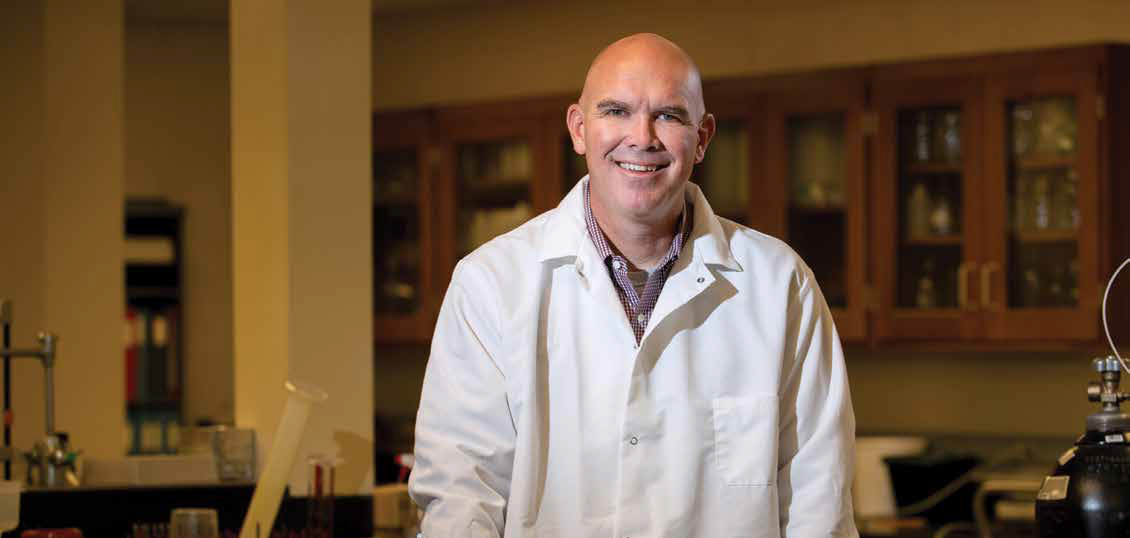
Gut Health in Pigs Tells a Larger Story:
Understanding Gut Health in Pigs and Connection to Humans

Maintaining and improving gut health is critical to improving overall health. With respect to anatomy and physiology, the pig gastrointestinal tract is highly similar to humans, which makes the pig a great model for understanding gut health in humans, according to Thomas Burkey, associate professor and gut health scientist in the Department of Animal Science at the University of Nebraska–Lincoln.
“The physiology of the pig is very similar to humans,” Burkey said. “The way humans and pigs assimilate nutrients is very similar and the immune system of pigs and humans is more similar than it is to most other species. There is quite a bit of data to support that the pig is a very good model for human research.”
Burkey’s research focuses on understanding gut health of pigs with the goal of improving the gut health not only in pigs, but also in all nonruminant animals and humans. Nonruminant animals, also referred to as monogastric animals, are simple-stomached animals. Humans, cats, dogs, pigs and chickens are all considered nonruminants, according to Burkey.
Nonruminant nutrition, then, is being able to meet the requirements of those simple-stomached animals compared to ruminant animals. Ruminant animals have a more complex digestive tract and nutritional scheme.
“The real takeaway of gut health research is thinking about the interactions between nutrition, the gut microbes and the gut immune components,” Burkey said. “Nutrition solves a lot of problems, but there's more to the puzzle than just nutrition.”
“If we can do a better job of figuring out how nutrition and health interact, especially for sick animals, we have the opportunity to be very impactful,” Burkey said.
A focus on gut health in pigs from birth to weaning can also lead to finding alternatives to antibiotics, according to Burkey. Understanding the microbes in the gastrointestinal tract and what those microbes are doing is most important. Ultimately, maintain/improving gut health increases the potential of a more sustainable production cycle.
Alternatives to Antibiotics
To improve gut health, Burkey said that prebiotics and probiotics can be used as an alternative to antibiotics. He defined prebiotics as a type of fiber that the body cannot digest. Prebiotics selectively stimulate growth or activity of bacteria within the gut. Probiotics are viable microbes that may provide beneficial effects to the host, according to Burkey.
“The goal is to match the prebiotic to the probiotic to have a greater impact on gut health,” Burkey said. Therefore, to understand gut health, one must find out what prebiotics are present and then match the microbes (probiotics) that are selectively enriched with that prebiotic.
Ideally, this would improve gut health, at least theoretically, Burkey said. If prebiotics and probiotics are correctly matched, producers may have a healthier, more efficient, heavier animal at weaning. If done correctly, issues are resolved proactively, rather than reactively with antibiotics after an issue arises. This study with pigs has led to a stronger connection to human gut health.
“We have data utilizing gnotobiotic pig and mouse models that supports that a pig model is better than a mouse model,” Burkey said. “That's one of the most interesting and fun things that we've identified over the past five years.”
This idea has the potential to impact not only pork production systems, but also can be used as a human model to look at metabolic diseases and the impacts of probiotics and prebiotics.

The Future is Big Data and Technology
The use of big data and technology is the wave of the future in gut health research, according to Burkey. An abundance of big data exists. However, at this point, the amount of data is difficult to organize and manage.
“There's so much information out there, we just need to figure out a way to use it,” Burkey said. There is a need to have a central repository for all of the data collected and to make it easy for scientists to put the data collected into that repository. There is also a need for an engineer to derive algorithms to make that data useful.”
In his study of pigs, Burkey generates a lot of data about what microbes are present and how the microbial profile changes as the pigs are fed different foods.
“What we don't know and what we need to know more about is what the microbes are doing, how they affect metabolism in the animal and how they are impacting nutrient assimilation,” Burkey said. “The next step is to use the big data to hone in on what exactly are those microbes doing.”
Technology advances will also steer the direction of gut health research in the future.
“Technology that tracks animals from a visual perspective will be key,” Burkey said. “Using RFID tags and cameras, for example, would be beneficial to track the health of animals.”
It is important to identify sick animals early so producers can intervene quickly and have healthier animals. Technology advances may help to maintain or improve gut health in pigs.
The Future is Multidisciplinary Teams
Gut health research is regularly shared with producers in the field. Burkey said it takes multidisciplinary teams to get answers to producers in a timely fashion.
“I rely on interactions from a lot of different people to try to make sense of all the information that's out there and try to formulate a research plan to help producers by providing answers to them,” Burkey said.
Burkey serves as the U.S. representative to Digestive Physiology in Pigs. This research group meets every three years and includes scientists from all over the world who talk about gut health, gut immunity, digestive physiology and gut microbiology.
“We are able to interact locally, nationally, internationally and have an opportunity to impact agriculture and provide answers for producers,” Burkey said. The conversation is geared towards sustainable production systems and looking at the whole system.